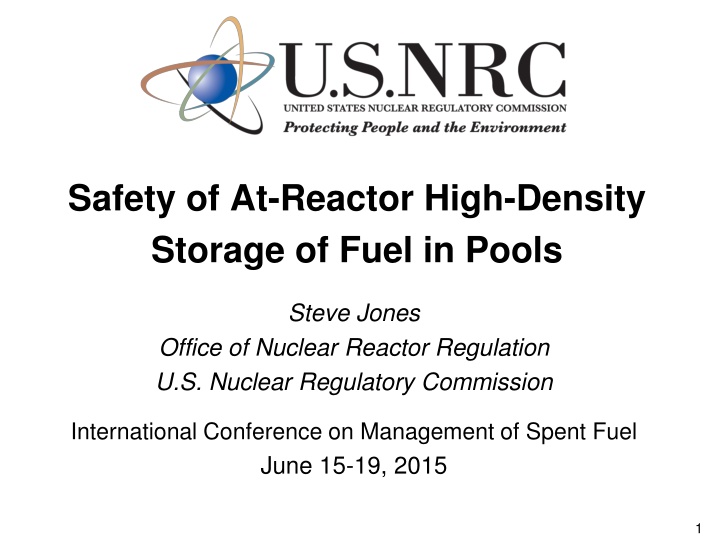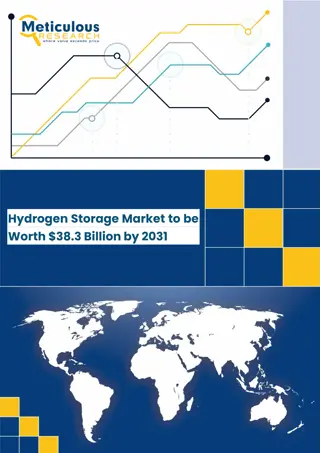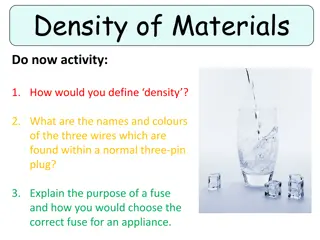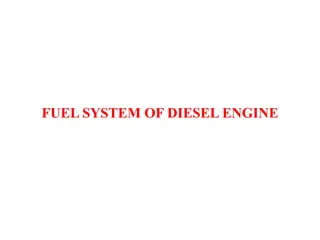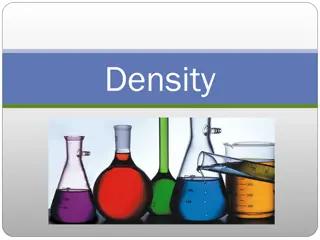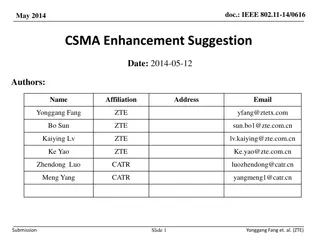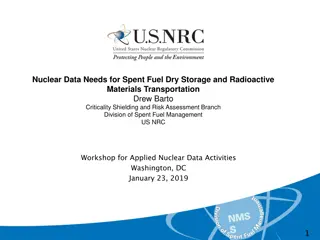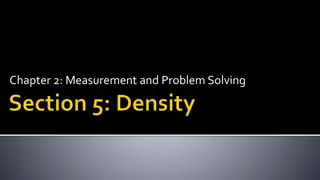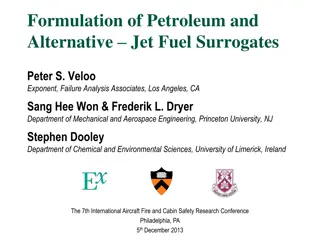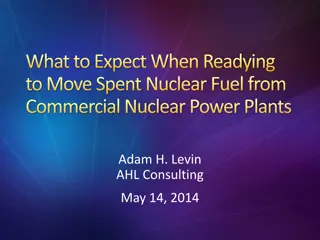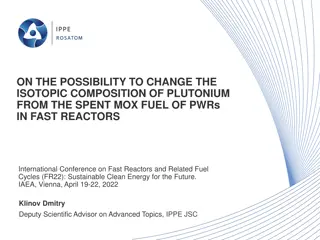Enhancing Safety and Management of Spent Fuel in High-Density Storage
This informative presentation delves into the safety measures and regulatory changes surrounding the storage of spent fuel in high-density pools. Topics covered include the design of spent fuel pools, historical regulatory activities, past studies on fuel uncovery risks, and advancements in analytical tools for enhanced safety. Key discussions focus on improving pool safety, fuel configurations, and mitigation strategies.
Download Presentation

Please find below an Image/Link to download the presentation.
The content on the website is provided AS IS for your information and personal use only. It may not be sold, licensed, or shared on other websites without obtaining consent from the author.If you encounter any issues during the download, it is possible that the publisher has removed the file from their server.
You are allowed to download the files provided on this website for personal or commercial use, subject to the condition that they are used lawfully. All files are the property of their respective owners.
The content on the website is provided AS IS for your information and personal use only. It may not be sold, licensed, or shared on other websites without obtaining consent from the author.
E N D
Presentation Transcript
Safety of At-Reactor High-Density Storage of Fuel in Pools Steve Jones Office of Nuclear Reactor Regulation U.S. Nuclear Regulatory Commission International Conference on Management of Spent Fuel June 15-19, 2015 1
Agenda Background Regulatory Changes Spent Fuel Pool Consequence Study Regulatory Analysis Modeling, Assumptions, and Results Conclusion 2
Spent Fuel Safety Spent Fuel Pools (SFP) originally designed for limited storage of spent fuel (low-density) SFPs are robust structures, with reinforced concrete walls and floors 3 to 6 feet thick Leak-tight stainless steel liner plates, typically inch thick, line the walls and floors of SFPs Safe pool storage of spent fuel achieved by maintaining water inventory and geometry Special features to protect against cask drops 3
History of Regulatory Activities Comprehensive Site Level 3 PRA Study Action Plan Activities to Increase SFP Cooling Reliability (mid-90s) (~2018) NUREG-2161 Spent Fuel Pool Study (2013) Transition to High- Density SFP Racking (starting in late 70s) National Academy of Sciences Study (2004) Post-Fukushima Activities (2011 2016) Early SFP Consequence Studies (e.g., NUREG/CR- 0649) and High-Density Racking Review Criteria Development (late 70s) NUREG-1738 Study for Decommissioning (1999 2001) COMSECY 2013-030 Expedited Transfer Analysis(2013) Post-9/11 Security Activities (2001 2009) NUREG-1353 Resolution of Generic Issue 82, Beyond Design Basis Accidents in Spent Fuel Pools (late-80s) 4
Past SFP Studies Annual frequency of SFP fuel uncovery as reported in previous SFP risk studies NUREG-1353* NUREG-1738** Cask / Heavy Load Drop Cask / Heavy Load Drop Seismic Seismic Other Other *BWR, best estimate results **Based on Livermore hazard curves which generally more closely match the updated USGS curves for the studied plant Past SFP risk studies indicate that seismic hazard is the most prominent contributor to fuel uncovery. These studies found high-density spent fuel storage to be safe. 5
Enhancements to Pool Safety Improved Fuel Configuration Mitigation Strategies (Portable Water Make-up and Spray) 7
Interest in Low Density Storage Uncertainty about status of Fukushima Unit 4 pool in aftermath of earthquake/tsunami prompted increased calls for low-density storage Actual performance of structure provided increased assurance in the robust design and construction of the pool 8
Consequence Study (NUREG-2161) Responds to concerns by using state-of-the-art tools to evaluate accident progression after a large earthquake BWR4 Mark I was used as reference plant Two conditions considered: Representative of the current situation for the reference plant (i.e., high-density loading and a relatively full SFP) Representative of expedited movement of older fuel to a dry cask storage facility (i.e., low-density loading) Study updates publicly available consequence estimates for spent fuel pool accidents 9
Consequence Study Insights Release frequency independent of storage density and strongly affected by likelihood of mitigation Magnitude of release may be significantly larger for high-density compared to low-density storage Significant release of long-lived radionuclides possible but unlikely Event evolves slowly and protective actions would be effective in limiting health effects Consequences of releases from high-density configurations generally consistent with results of past studies 11
Cask Loading to Reduce Density Source: Technical Report 1021049, Impacts Associated with Transfer of Spent Nuclear Fuel from Spent Fuel Storage Pools to Dry Storage After Five Years of Cooling, EPRI, November 2010. 12
Evaluation Process Safety Goal Screening Evaluation Based on the Commission Safety Goal Policy Statement (1986) Used the Quantitative Health Objectives (QHOs) to evaluate achievement of the safety goals Cost/Benefit Analysis Intended to identify maximum potential benefit Analyzes costs and benefits for representative pool design groups Sensitivity Studies Evaluates key factors to illustrate their effect on the final result 13
Safety Goal Screening Results Reduced density offers limited safety benefit based on comparison with QHOs No risk of fatalities due to nature of release Potential benefit is a very small fraction (0.76%) of latent cancer goal Cancer risk relatively insensitive to magnitude of release due to slow accident progression and effective protective actions Sufficient margin to QHOs that a substantial improvement in overall health and safety from reduced density unlikely 14
Cost-Benefit Analysis Evaluated one alternative - Expedited Transfer Transfer fuel with more than 5 years decay to dry casks Store remaining fuel in low-density configuration in existing racks Major Assumptions Initiating SFP Event Frequencies and Accident Progression Seismic Hazard from USGS 2008 Information Other event frequencies from NUREG-1738 and NUREG-1353 Maximize benefit of low density option Mitigation credited for low density case only Release fractions informed by consequence study Economic modeling (e.g., definition of representative plants, future spent fuel discharge projections, etc.) Timing (e.g., dry cask storage loading, occupational dose, etc.) Result Costs exceed estimated benefits for base case 15
Additional Safety Enhancements Enhanced mitigation capabilities/strategies Delivery of make-up water via portable pump connection to pool cooling system Equipment redundancy for make-up and spray Capability to vent spent fuel pool area Wide-range pool level instrumentation Ability to monitor pool conditions following extreme events Seismic hazard re-evaluation and verification of seismic design margin 16
Conclusions High-density storage of fuel in pools is safe Frequency of events that challenge safe storage of fuel is low Measures of impact on public health and safety are well within goal values Defense-in-depth enhanced by improved mitigation capability The added costs of establishing low-density SFP storage are not warranted in light of the marginal safety benefits Additional studies are not needed to further refine the differences in event frequencies and consequences for low-density and high-density storage configurations 17
